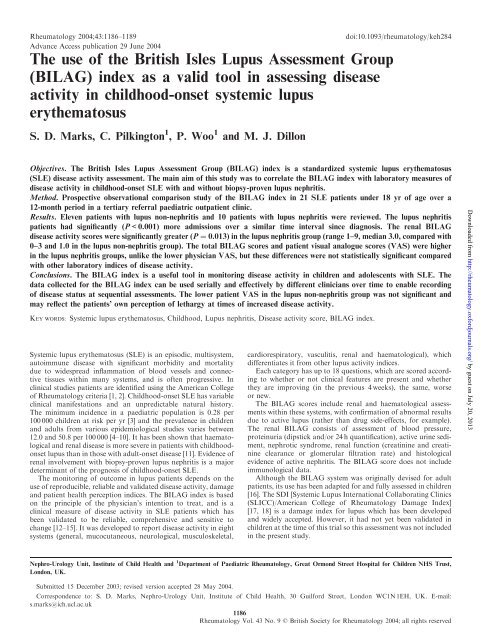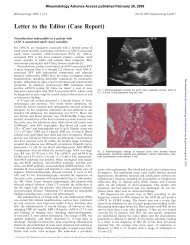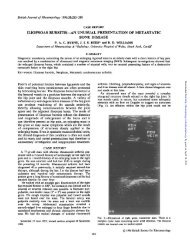The use of the British Isles Lupus Assessment Group (BILAG) index ...
The use of the British Isles Lupus Assessment Group (BILAG) index ...
The use of the British Isles Lupus Assessment Group (BILAG) index ...
Create successful ePaper yourself
Turn your PDF publications into a flip-book with our unique Google optimized e-Paper software.
Rheumatology 2004;43:1186–1189 doi:10.1093/rheumatology/keh284<br />
Advance Access publication 29 June 2004<br />
<strong>The</strong> <strong>use</strong> <strong>of</strong> <strong>the</strong> <strong>British</strong> <strong>Isles</strong> <strong>Lupus</strong> <strong>Assessment</strong> <strong>Group</strong><br />
(<strong>BILAG</strong>) <strong>index</strong> as a valid tool in assessing disease<br />
activity in childhood-onset systemic lupus<br />
ery<strong>the</strong>matosus<br />
S. D. Marks, C. Pilkington 1 , P. Woo 1 and M. J. Dillon<br />
Objectives. <strong>The</strong> <strong>British</strong> <strong>Isles</strong> <strong>Lupus</strong> <strong>Assessment</strong> <strong>Group</strong> (<strong>BILAG</strong>) <strong>index</strong> is a standardized systemic lupus ery<strong>the</strong>matosus<br />
(SLE) disease activity assessment. <strong>The</strong> main aim <strong>of</strong> this study was to correlate <strong>the</strong> <strong>BILAG</strong> <strong>index</strong> with laboratory measures <strong>of</strong><br />
disease activity in childhood-onset SLE with and without biopsy-proven lupus nephritis.<br />
Method. Prospective observational comparison study <strong>of</strong> <strong>the</strong> <strong>BILAG</strong> <strong>index</strong> in 21 SLE patients under 18 yr <strong>of</strong> age over a<br />
12-month period in a tertiary referral paediatric outpatient clinic.<br />
Results. Eleven patients with lupus non-nephritis and 10 patients with lupus nephritis were reviewed. <strong>The</strong> lupus nephritis<br />
patients had significantly (P
<strong>The</strong> methods <strong>of</strong> assessing disease severity are always open<br />
to discussion in relation to children with lupus. Many believe<br />
that clinical assessment should take precedence over laboratory<br />
investigations. However, it is well recognized that <strong>the</strong>re may be<br />
changes in <strong>the</strong> results <strong>of</strong> investigations suggesting a flare in disease<br />
activity even though <strong>the</strong> patient is clinically well, and at o<strong>the</strong>r times<br />
clinical evidence <strong>of</strong> disease activity without commensurate laboratory<br />
abnormalities.<br />
<strong>The</strong> main aim <strong>of</strong> this study was to compare <strong>the</strong> validity <strong>of</strong><br />
<strong>the</strong> <strong>BILAG</strong> <strong>index</strong> in children and adolescents with SLE between<br />
two groups <strong>of</strong> patients: those with biopsy-proven lupus nephritis<br />
and those without. Our hypo<strong>the</strong>sis was that if <strong>the</strong> <strong>BILAG</strong><br />
<strong>index</strong> is valid, <strong>the</strong>n it will be scored significantly higher in those<br />
patients with lupus nephritis. We also wanted to determine <strong>the</strong><br />
correlation between <strong>the</strong> total <strong>BILAG</strong> score and clinical and<br />
laboratory measures <strong>of</strong> disease activity [such as erythrocyte sedimentation<br />
rate, C-reactive protein, antinuclear antibody, antidouble-stranded<br />
DNA antibody, complement C3 and C4 and<br />
anticardiolipin immunoglobulin (Ig) G and IgM antibody].<br />
Subjects and methods<br />
This was a cohort study <strong>of</strong> paediatric and adolescent patients with<br />
SLE reviewed at <strong>the</strong> tertiary referral clinics <strong>of</strong> <strong>the</strong> Departments<br />
<strong>of</strong> Nephrology and/or Rheumatology at Great Ormond Street<br />
Hospital for Children NHS Trust.<br />
Due to <strong>the</strong> nature <strong>of</strong> tertiary referrals, <strong>the</strong>se patients tend to be<br />
at <strong>the</strong> severe end <strong>of</strong> <strong>the</strong> spectrum <strong>of</strong> childhood disease activity. All<br />
<strong>the</strong> patients were seen at additional out-patient appointments<br />
in a joint nephrology and rheumatology clinic specifically set up<br />
for lupus patients at Great Ormond Street Hospital for Children<br />
NHS Trust for <strong>the</strong> purpose <strong>of</strong> this study. <strong>The</strong> subjects <strong>of</strong> <strong>the</strong> study<br />
were identified by a search <strong>of</strong> <strong>the</strong> hospital’s Patient Information<br />
Management Systems (PIMS) and <strong>the</strong> Nephrology Patient<br />
Database.<br />
Twenty-five lupus patients were invited to attend <strong>the</strong> clinic, <strong>of</strong><br />
whom 21 consented: 10 patients had lupus nephritis (clinical and<br />
biopsy-proven), referred to as <strong>the</strong> ‘lupus nephritis’ group, and 11<br />
had no clinical or laboratory evidence <strong>of</strong> renal involvement at <strong>the</strong><br />
time <strong>of</strong> analysis, referred to as <strong>the</strong> ‘lupus non-nephritis’ group.<br />
Full clinical assessment (history, examination and investigations)<br />
was undertaken on all patients. <strong>The</strong> severity <strong>of</strong> disease<br />
TABLE 1. Baseline characteristics <strong>of</strong> patients<br />
No. <strong>of</strong><br />
patients<br />
Age range<br />
(median) (yr)<br />
TABLE 2. Individual system <strong>BILAG</strong> scores in lupus case groups<br />
activity in <strong>the</strong> cases was analysed manually using version 3 <strong>of</strong> <strong>the</strong><br />
<strong>BILAG</strong> <strong>index</strong> [13] assessment form, which rates clinical and<br />
laboratory manifestations in each <strong>of</strong> <strong>the</strong> eight organ systems.<br />
To provide numerical scores, we <strong>use</strong>d a previous weighting<br />
system that assigned a score <strong>of</strong> 9 to active manifestations (grade<br />
A in <strong>the</strong> <strong>BILAG</strong>), 3 to grade B manifestations, 1 to grade C manifestations,<br />
and 0 to grade D and E manifestations. We <strong>use</strong>d <strong>the</strong><br />
sum <strong>of</strong> <strong>the</strong>se scores as a summary <strong>index</strong> (possible range 0–72) [15].<br />
One unblinded physician (S.D.M.) and all patients completed<br />
visual analogue scales (VAS); <strong>the</strong> patients marked on a 10-cm scale<br />
how well <strong>the</strong>y felt in general, 0 denoting very ill and 10 denoting<br />
completely well [19].<br />
<strong>The</strong> data were analysed with SPSS 11.0 s<strong>of</strong>tware for Windows.<br />
Statistical significance was derived using non-parametric tests such<br />
as <strong>the</strong> Mann–Whitney U, Wilcoxon W and Kruskal–Wallis tests.<br />
Ethical approval was obtained for this study from <strong>the</strong> Institute<br />
<strong>of</strong> Child Health and Great Ormond Street Hospital for Children<br />
NHS Trust Research Ethics Committee, and written consent was<br />
obtained for all cases.<br />
Results<br />
Baseline characteristics<br />
Baseline characteristics <strong>of</strong> <strong>the</strong> patients in <strong>the</strong> lupus nephritis and<br />
lupus non-nephritis groups, in terms <strong>of</strong> age, sex ratio, time since<br />
diagnosis and number <strong>of</strong> admissions since diagnosis were identified.<br />
<strong>The</strong>se are shown in Table 1, with time from diagnosis and<br />
comparisons between <strong>the</strong> groups showing similarity in age and<br />
sex ratio. Due to <strong>the</strong> expected severity <strong>of</strong> disease activity in <strong>the</strong><br />
lupus nephritis group, this group showed a statistically significant<br />
increase in <strong>the</strong> number <strong>of</strong> hospital admissions over a similar timeinterval<br />
since diagnosis. All 10 patients with lupus nephritis had<br />
evidence <strong>of</strong> active renal disease at <strong>the</strong> time <strong>of</strong> <strong>the</strong>ir previous biopsy,<br />
which was undertaken between 0.1 and 1.8 (median <strong>of</strong> 0.8) yr prior<br />
to <strong>the</strong> <strong>BILAG</strong> <strong>index</strong> assessment.<br />
Clinical disease activity<br />
<strong>The</strong> individual system <strong>BILAG</strong> scores are shown in Table 2.<br />
As might be expected, <strong>the</strong> lupus nephritis group had statistically<br />
Sex ratio<br />
(F:M)<br />
Range <strong>of</strong> years<br />
since diagnosis (median)<br />
Range <strong>of</strong> number<br />
<strong>of</strong> admissions (median)<br />
<strong>Lupus</strong> non-nephritis 11 11.8–17.8 (14.7) 8:3 0.3–12.8 (2.6) 1–12 (8)<br />
<strong>Lupus</strong> nephritis 10 11.3–17.7 (15.3) 7:3 1.9–12.6 (4.4) 9–91 (17)<br />
P P ¼ 0.43 P ¼ 0.92 P ¼ 0.22 P
1188 S. D. Marks et al.<br />
TABLE 3. Analysis <strong>of</strong> <strong>the</strong> <strong>BILAG</strong> and VAS scores in lupus case groups<br />
Range <strong>of</strong> renal<br />
<strong>BILAG</strong> scores (median)<br />
TABLE 4. Analysis <strong>of</strong> ranges (medians) <strong>of</strong> laboratory measures <strong>of</strong> disease activity in lupus cases<br />
ESR CRP ANA dsDNA C3 C4 AC IgG Ab AC IgM Ab<br />
Normal range<br />
and units<br />
1–10 mm/h
<strong>The</strong> authors have declared no conflicts <strong>of</strong> interest.<br />
References<br />
1. Tan EM, Cohen AS, Fries JF et al. <strong>The</strong> 1982 revised criteria for<br />
<strong>the</strong> classification <strong>of</strong> systemic lupus ery<strong>the</strong>matosus. Arthritis Rheum<br />
1982;25:1271–7.<br />
2. Hochberg MC. Updating <strong>the</strong> American College <strong>of</strong> Rheumatology<br />
revised criteria for <strong>the</strong> classification <strong>of</strong> systemic lupus ery<strong>the</strong>matosus.<br />
Arthritis Rheum 1997;9:1725.<br />
3. Malleson PN, Fung MY, Rosenberg AM. <strong>The</strong> incidence <strong>of</strong> pediatric<br />
rheumatic diseases: results from <strong>the</strong> Canadian Pediatric Rheumatology<br />
Association Disease Registry. J Rheumatol 1996;23:1981–7.<br />
4. Siegel M, Lee SL. <strong>The</strong> epidemiology <strong>of</strong> systemic lupus ery<strong>the</strong>matosus.<br />
Semin Arthritis Rheum 1973;3:1–54.<br />
5. Nived O, Sturfelt G, Wollheim F. Systemic lupus ery<strong>the</strong>matosus<br />
in an adult population in sou<strong>the</strong>rn Sweden: incidence, prevalence<br />
and validity <strong>of</strong> ARA revised classification criteria. Br J Rheumatol<br />
1985;24:147–54.<br />
6. Hochberg MC. Prevalence <strong>of</strong> systemic lupus ery<strong>the</strong>matosus in<br />
England and Wales, 1981–2. Ann Rheum Dis 1987;46:664–6.<br />
7. Fessel WJ. Systemic lupus ery<strong>the</strong>matosus in <strong>the</strong> community. Arch<br />
Intern Med 1974;134:1027–35.<br />
8. Hopkinson ND, Doherty M, Powell RJ. <strong>The</strong> prevalence and incidence<br />
<strong>of</strong> systemic lupus ery<strong>the</strong>matosus in Nottingham, UK, 1989–1990. Br J<br />
Rheumatol 1993;32:110–5.<br />
9. Hopkinson ND, Doherty M, Powell RJ. Clinical features and racespecific<br />
incidence/prevalence rates <strong>of</strong> systemic lupus ery<strong>the</strong>matosus<br />
in a geographically complete cohort <strong>of</strong> patients. Ann Rheum Dis<br />
1994;53:675–80.<br />
10. Johnson AE, Gordon C, Palmer RG, Bacon PA. <strong>The</strong> prevalence and<br />
incidence <strong>of</strong> systemic lupus ery<strong>the</strong>matosus in Birmingham, England.<br />
Relationship to ethnicity and country <strong>of</strong> birth. Arthritis Rheum<br />
1995;38:551–8.<br />
11. Tucker LB, Menon S, Schaller JG, Isenberg DA. Adult- and<br />
childhood-onset systemic lupus ery<strong>the</strong>matosus: a comparison <strong>of</strong> onset,<br />
clinical features, serology, and outcome. Br J Rheumatol 1995;34:<br />
866–72.<br />
Use <strong>of</strong> <strong>BILAG</strong> to assess childhood SLE 1189<br />
12. Symmons DP, Coppock JS, Bacon PA et al. Development and<br />
assessment <strong>of</strong> a computerized <strong>index</strong> <strong>of</strong> clinical disease activity in<br />
systemic lupus ery<strong>the</strong>matosus. Members <strong>of</strong> <strong>the</strong> <strong>British</strong> <strong>Isles</strong> <strong>Lupus</strong><br />
<strong>Assessment</strong> <strong>Group</strong> (<strong>BILAG</strong>). Q J Med 1988;79:927–37.<br />
13. Hay EM, Bacon PA, Gordon C et al. <strong>The</strong> <strong>BILAG</strong> <strong>index</strong>: a reliable<br />
and valid instrument for measuring clinical disease activity in systemic<br />
lupus ery<strong>the</strong>matosus. Q J Med 1993;86:447–58.<br />
14. Isenberg DA, Gordon C. From <strong>BILAG</strong> to BLIPS—disease activity<br />
assessment in lupus past, present and future. Members <strong>of</strong> <strong>the</strong> <strong>British</strong><br />
<strong>Isles</strong> <strong>Lupus</strong> <strong>Assessment</strong> <strong>Group</strong> (<strong>BILAG</strong>). <strong>Lupus</strong> 2000;9:651–4.<br />
15. Stoll T, Stucki G, Malik J, Pyke S, Isenberg DA. Fur<strong>the</strong>r validation<br />
<strong>of</strong> <strong>the</strong> <strong>BILAG</strong> disease activity <strong>index</strong> in patients with systemic lupus<br />
ery<strong>the</strong>matosus. Ann Rheum Dis 1996;55:756–60.<br />
16. Brunner HI, Feldman BM, Bombardier C, Silverman ED. Sensitivity<br />
<strong>of</strong> <strong>the</strong> Systemic <strong>Lupus</strong> Ery<strong>the</strong>matosus Disease Activity Index,<br />
<strong>British</strong> <strong>Isles</strong> <strong>Lupus</strong> <strong>Assessment</strong> <strong>Group</strong> Index, and Systemic <strong>Lupus</strong><br />
Activity Measure in <strong>the</strong> evaluation <strong>of</strong> clinical change in childhoodonset<br />
systemic lupus ery<strong>the</strong>matosus. Arthritis Rheum 1999;42:<br />
1354–60.<br />
17. Gladman D, Ginzler E, Goldsmith C et al. <strong>The</strong> development and<br />
initial validation <strong>of</strong> <strong>the</strong> Systemic <strong>Lupus</strong> International Collaborating<br />
Clinics/American College <strong>of</strong> Rheumatology damage <strong>index</strong> for<br />
systemic lupus ery<strong>the</strong>matosus. Arthritis Rheum 1996;39:363–9.<br />
18. Ravelli A, Duarte-Salazar C, Buratti S et al. <strong>Assessment</strong> <strong>of</strong> damage<br />
in juvenile-onset systemic lupus ery<strong>the</strong>matosus: a multicenter cohort<br />
study. Arthritis Rheum 2003;49:501–7.<br />
19. Alarcon GS, McGwin G Jr, Brooks K et al. Systemic lupus<br />
ery<strong>the</strong>matosus in three ethnic groups. XI. Sources <strong>of</strong> discrepancy in<br />
perception <strong>of</strong> disease activity: a comparison <strong>of</strong> physician and patient<br />
visual analog scale scores. Arthritis Rheum 2002;47:408–13.<br />
20. Brunner HI, Silverman ED, Bombardier C, Feldman BM. European<br />
Consensus <strong>Lupus</strong> Activity Measurement is sensitive to change in<br />
disease activity in childhood-onset systemic lupus ery<strong>the</strong>matosus.<br />
Arthritis Rheum 2003;49:335–41.<br />
21. Chang ER, Abrahamowicz M, Ferland D, Fortin PR. Organ<br />
manifestations influence differently <strong>the</strong> responsiveness <strong>of</strong> 2 lupus<br />
disease activity measures, according to patients’ or physicians’<br />
evaluations <strong>of</strong> recent lupus activity. J Rheumatol 2002;29:2350–8.<br />
Downloaded from<br />
http://rheumatology.oxfordjournals.org/ by guest on July 20, 2013















